Рождение детей как фактор регресса социально-экономического положения семьи
Aннотация
В статье рассматриваются результаты исследования влияния рождения детей на социально-экономическое положение семьи. Общественный и научный дискурс признает существенную роль экономического фактора в принятии решения о рождении определенного количества детей до самого события. Однако, имеется небольшое количество работ, в которых оцениваются уже реализованные репродуктивные установки на изменение социально-экономического статуса семьи. Авторы рассмотрели известные теоретические основы «экономической теории рождаемости» Г. Беккера и Р. Истерлиной, «демографического перехода» Ф. Ю. Нотштейна и других зарубежных и отечественных исследователей в связи с трансформацией современной ситуации процессов рождаемости в России. Исследование выявило более сложную связь между рождаемостью и социально-экономическим положением семьи, которая в данном исследовании носила регрессивный характер. Показано, что рождение детей в современных социально-экономических условиях России ухудшает удовлетворенность семей своим материальным положением в зависимости от количества детей и формирует потенциал малообеспеченного населения. Вдобавок к этому развивается дефицит средств, а также ускоряется ухудшение жилищных условий более высокими темпами в многодетных семьях. Важным выводом исследования для уточнения масштабов и направлений социально-демографической политики в России и других странах, испытывающих аналогичные проблемы, является вывод о том, что появление в семье каждого ребенка ухудшает ее социально-экономическое положение на 10-30%.
Ключевые слова: семья, дети, плодородие, регресс, социоэкономический статус, семья, доходы, демографическая политика
Introduction. Interest in this topic is due to the fact that in the modern world, under the influence of the ideology of economic determinism and consumer society, the birth of children becomes utilitarian. New generations are increasingly approaching the creation of a family and the birth of a child from the standpoint of the “benefit-cost” dichotomy. The birth of a child ceases to be an unconditional value and becomes the subject of commercial evaluation. This is due to the fact that modern living standards, often imposed by the media and marketers, require significant material, financial and time costs for the birth and upbringing of children. A child is perceived by society as an expensive and long-term “investment project”, the “dividends” from which are not guaranteed.
Russia participates in world global trends, which are characterized by individualism and atomization of society, deepening socio-economic inequality, shrinking family structureand decreasing childbirth, but still has a number of features in comparison with other countries. Thus, the share of households consisting of one person is less (26%) than in Europe and the United States, the share of married couples without children is also much less (16%) than in these countries.
The last 30 years, which are characterized by depopulation trends in Russia (the first and second waves), have formed an active position of the state to overcome them. At the same time, the existing socio-economic conditions to a significant extent hinder the processes of restoring demographic progress at the level of the whole society and at the level of individual families.
Methodology and methods. The theoretical approaches of this work were based on classical works of Western and domestic demographers, sociologists and economists, as well as articles by modern researchers about the role of socio-economic influence on reproductive processes. It should be noted that a significant part of scientific publications present studies of fertility processes transformation. They focus on the role of economic conditions that form the motivation to have children. The idea of rationalizing reproductive behavior due to economic factors is asserted starting with the well-known “economic theory of fertility” by G. Becker (Becker, 1960, 1993).
In macroeconomic theory This idea was developed by R. Easterlin in macroeconomic theory (Easterlin, 1961, 1981, 2011). He argued that the relationship between income and fertility does not depend on absolute, but on relative income. This hypothesis continues to be tested by his followers, who confirm the validity of the theoretical model, but only for high-income countries (Dupke at al., 2015; Hill, 2015; Manukovich, 1998; Jeon at al., 2005). H. Leibenstein noted that “pure economic theory does not explain all variations in fertility; it is necessary to take into account the socio-economic processes that are the result of economic development” (Leibenstein, 1974).
The importance of economic incentives in the processes of fertility is also laid down in the theory of “demographic transition”. The essence of this theory is a gradual decrease in fertility and mortality rates during the economic development of states. The works of the founder of this idea, F. W. Notstein, continue to be widely discussed in the scientific community even now (Notestein, 2009). The famous Russian demographer A. G. Vishnevsky was one of the first to try to adapt this theory to Soviet and then Russian reality (Vishnevsky, 2005, 2017, 2018). Other authors continue to explore this approach in a new situation (Sergeev at al., 2020; Eggleston and Fuchs, 2012; Muller, 1976).
Microeconomic studies of this problem detail the role of the economic factor, but indicate more complex relationship between it and other determinants of reproductive behavior. These works include the projects of E. Lehrer and M. Nerlav (Lehrer and Nerlav, 1981), S. Robinson and N. Thomes (Robinson and Tomes, 1982), M. O. Borg (Borg, 1989), J. Llovet (Llovet, 1989).
The works of domestic researchers who study the processes of fertility and reproductive behaviorhavea great theoretical value. They recognize the importance of economic conditions but not limited to them and proved the need to take into account other factors. The works of B. Ts. Urlanis (Urlanis, 1963), A. Ya. Boyarsky, D. I. Valentey, A. Ya. Kvasha (Boyarskiy at al., 1980; Kvasha, 1981), A. I. Antonov (Antonov, 1980), V. A. Borisov, A. B. Sinelnikov (Borisov and Sinelnikov, 1995), V. N. Arkhangelsky (Archangelsky, 2006), V. N. Medkov (Antonov at al., 2002) and other authors convincingly prove that economically deterministic demographic policy does not always lead to unambiguous increase in the birth rate. The economic factor is a necessary, but insufficient condition for influencing the processes of fertility. In conditions of economic instability, a guaranteed system of the state support of families with children is of particular importance. Itprovids basic expenses for the upbringing and education of the younger generation.
In our study, we focused on the aspect of the socio-economic status of the family, which is objectively transformed at the birth of a child. Moreover, the nature of the transformation is regressive.
Here the socio-economic status of the family is an integral characteristic that reflects the social and economic potential for the implementation of life strategies. It contains various components: total income, per capita income (its financial position), as well as the presence of property, housing conditions and other opportunities, or, on the contrary, the absence of such. Usually, the study of the socio-economic status of families classifies them into several groups with high, medium and low status. The first one is determined by a high level of income and quality of housing conditions that allow satisfying the basic needs of life. The second one is characterized by the level of income and housing conditions corresponding to the minimum social standards of living. The third one is determined by such material and housing conditions, which are below the established standards (for example, below the subsistence level) and do not allow satisfying basic needs in full.
The concept of regression in the context of the study had a classical interpretation as a decrease or deterioration in socio-economic status under the influence of any events: in this case, with the birth of children. This report will affect some aspects of our research.
Research Results and Discussion. Following the data of the last census in Russia in 2010 (since the new census planned in 2020 was postponed due to the pandemic), the country's population includes more than 17.5 million families with children under 18 years old. The most common are full families with children (Figure 1). Almost 30% consisting of a mother and children, and about 4% consisting of a fatherand children.
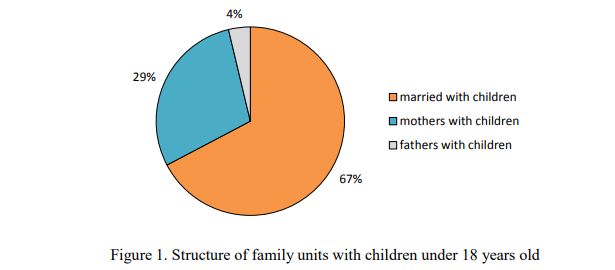
A typical family in Russia is a married couple with 1 child. There are more than 2/3 of such households (Figure 2). Every fourth family is also a family with 2 children. The share of households with a large number of children is about 6%. These data are presented in the results of the Russian Census of 2010. According to the Ministry of Labour and Social Protection of Russiaof January 1, 2019, the number of large families was 1.76 million, where more than 5.6 million children are being raised.
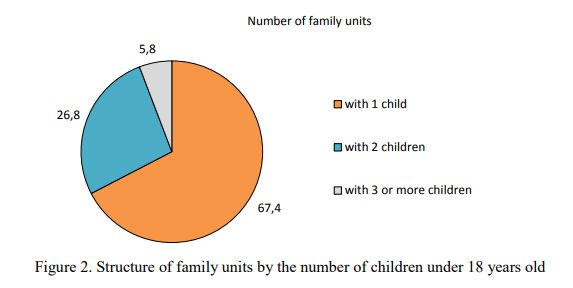
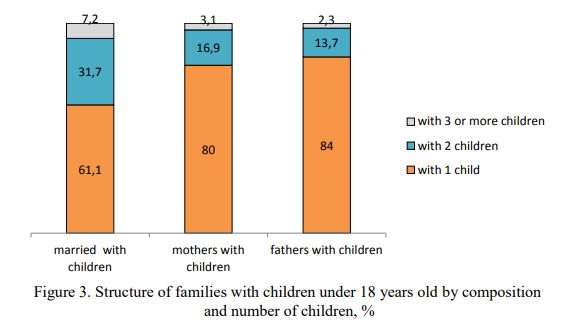
In the Figure 3 in all types of families, especially where there is only oneparent, the dominant family is a family with 1 child. There are relatively few families with many childrenwhere there is only one parent.
In recent years, the total fertility rate in Russia has been declining and in 2020 amounts to 1.48 children per 1 woman of reproductive age.This situation is characteristic not only of Russia. At the same time, it should be noted that the desired number of children, according to the results of many sociological studies, is greater than the real total coefficient. This is due to the fact that the prevailing socio-economic conditions hinder the implementation of the desired reproductive attitudes. This fact is indicated by the results of the author's sociological survey of intellectual youth, which was carried out in Russia, Kazakhstan and Kyrgyzstan. The survey showed that given the current socio-economic conditions, the ideal reproductive model is becoming less detailed. The number of respondents with “conscious childlessness” is also increasing (Figure 4, 5).
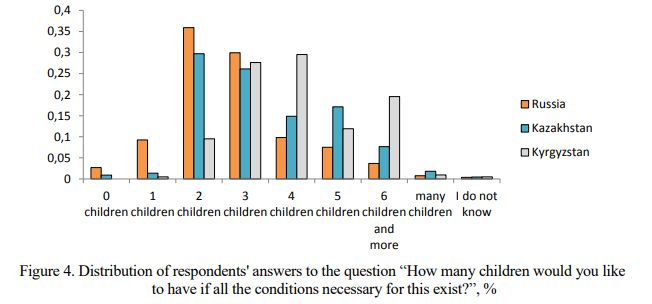
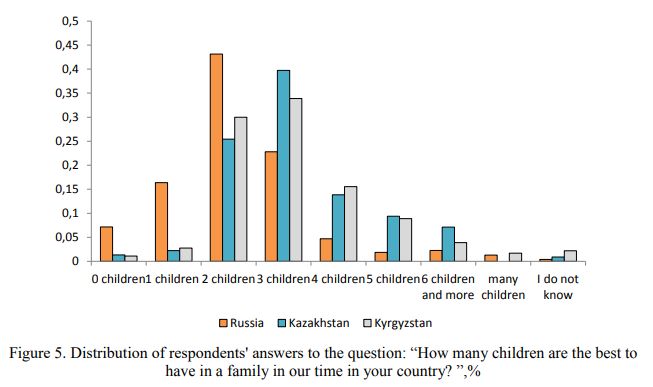
According to another all-Russian survey “Demographic Wellbeing of Russia” conducted by the Institute for Demographic Research of the Russian Academy of Sciences, financial difficulties and housing problems were among the main reasons for refusing to implement the desired reproductive attitudes (Table 1).

The results of a sample survey of households on the degree of satisfaction with their financial situation in 2019 (Table 2) show that only 2% of families with 1 child and 3% of families with 2 or more children have sufficient funds to buy everything they consider necessary.
Almost half of families with children (regardless of their number) have problems buying durable goods, which forces them to take out consumer loans. About one of four families does not have sufficient funds to buy a car. For 13% of families with 1 child, it is difficult to make mandatory payments for utilities and buy clothes. There are already more than 16% of families with more than 1 child with the same problems. As for buying an apartment, the problem of lack of funds is more noticeable in families with 1 child than with 2 or more children (8% versus 7.4%). This paradox is evidently due to the demographic policy of the state to stimulate the birth rate of the second and subsequent children (first of all, the payment of maternity capital at the birth of a second child). In addition, there are families who noted that they did not even have enough money for food (0.4% with 1 child and 0.8% with 2 or more children).
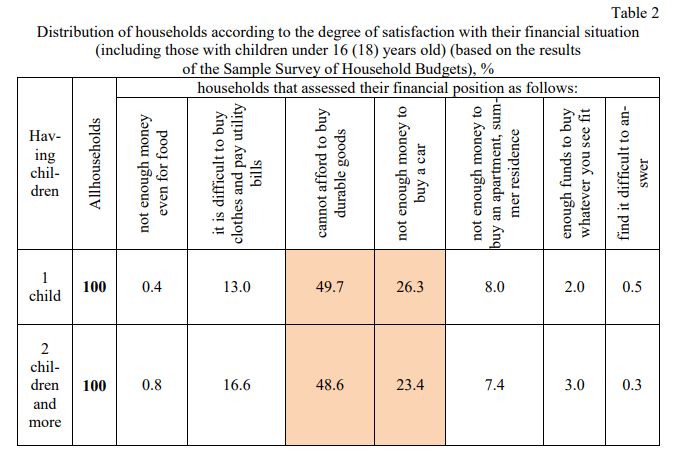
The evidence of the significant influence of childbirth on the socio-demographic status of a family is shown in the Figure 6. Here, the dynamics of the share of poor households in the total number of households in Russia is presented. Its value is not so great and in different years ranged from 6.6% to 8.9%. In addition, the share of low-income households with children under 18 years old in the total number of households with children is presented. In this case, its value ranges from 15.0% to 21.7%. Moreover, as the graph shows, this gap is growing by 2018. This means that having children in a family generally increases the family's poor status or poverty. In addition, the share of low-income families with small children (under 3 years old) in the total number of families with children under 3 years old is presented. Its indicators are even higher: from 22.1% to 34.5%. Also in recent years, the gap between the charts has been growing. This demonstrates that a particularly significant deterioration in socio-economic status is characteristic of young families with young children.
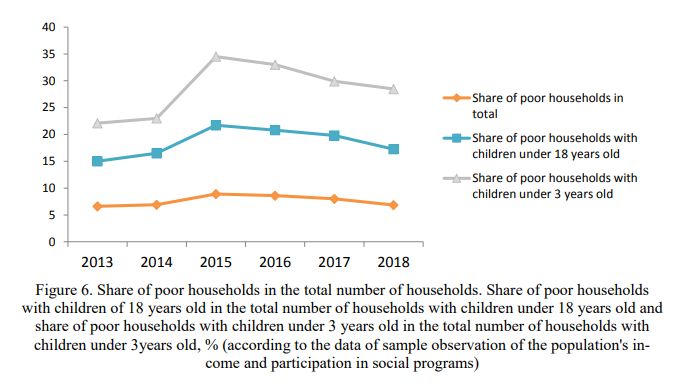
The data from the survey of cash income of households in Russia also recorded an increase in the deficit of cash income of low-income families with different numbers of children (Figure 7). It should be noted that in absolute numbers the shortage of funds for one family member with 1 child and 2 children is quite close. The growing deficit for such families is almost synchronous, but for low-income families with many children (3 or more), the shortage of funds increases and “breaks away” from the dynamics of less-child low-income families. This means that poverty in low-income families with many children continues to have a special dynamic and, in general, is getting worse over time.
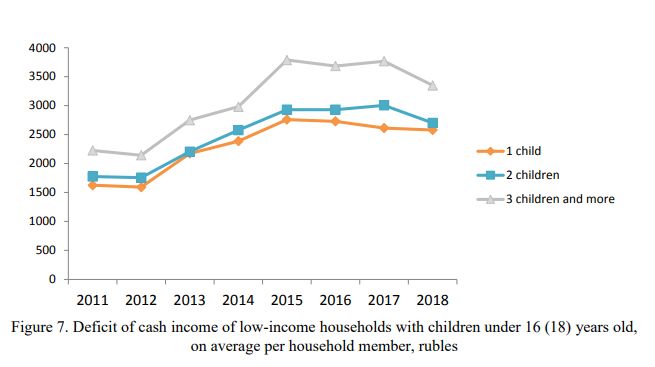
The same conclusion can be made on the basis of the following graph, which demonstrates the relative indicators of the shortfall in cash income of poor families with different numbers of children (Figure 8).
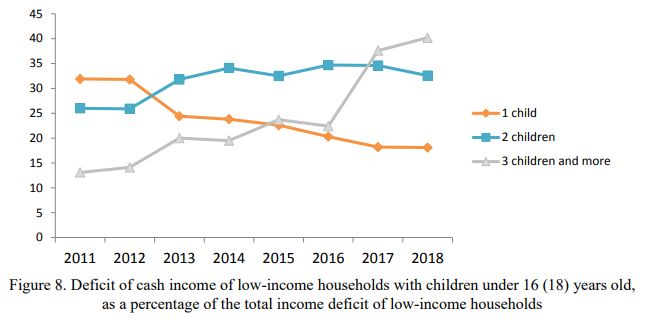
If in 2011 the aggregate deficit of low-income families with children in the total deficit of low-income families was 71.0%, then later it increased and in 2018 reached 90.9%. This is especially noticeable in the growth of the share of the deficit of low-income families with 3 or more children (3 times).
As for another significant factor holding back the birth of children, the housing problem, we note the following: it is clear that the appearance of a new family member objectively worsens living conditions. In Russia there is a state program “Housing for a Young Family” aimed at stimulating the birth of children. But if we pay attention to the Figure 9, we note that, despite the decrease after 2014 in the number of young families in need of housing, their number remains quite large: in 2018, more than 318 000 families. Moreover, the prospects for improving living conditions are not as great as it seems. The share of young families who were able to do it ranges: from 10% in 2011 to 7% in 2019. Therefore, the housing problem will be a constraining factor for the birth of children for a long time to come. Conversely, the birth of children will aggravate the living conditions of young families.
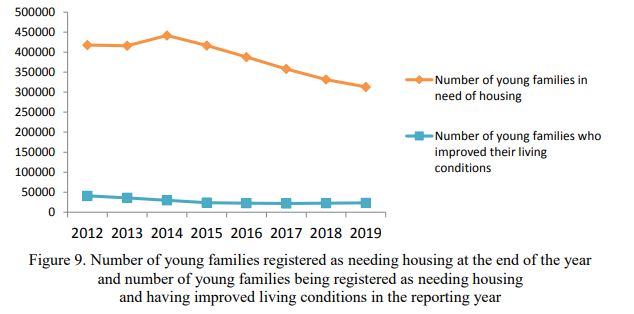
This also applies to large families seeking to improve living conditions (Figure 10). Their number is gradually increasing: in 2019 they amounted to more than 132 000 families. The share of those large families who received adequate housing or improved it reaches no more than 3% -5%.
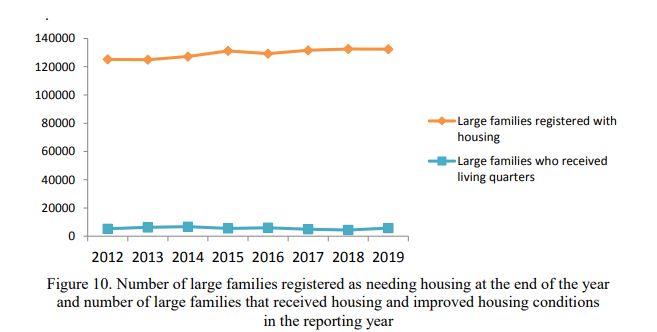
At the same time, Russia is doing a lot to support the birth of children. Since 2007, it has been implementing a program of“maternity (family) capital”, which was paid at the birth of a second and/or subsequent child. The amount of such payment is constantly growing. Since 2020, maternity capital has also been paid for the first-born and is already 484 000 rubles (about 6.5 thousand US dollars)in 2021. The birth of children in young families under 30 is additionally stimulated. From 2021, the methodology for calculating the subsistence minimum is changing, on the basis of which calculations are made on measures of social support for families with children.
In the context of a pandemic in Russia, special attention was paid to supporting families with children. Special payments in 2020 were the following:
- within three months, families with children under 3 years old: 5 000 rubles ($ 70) per month;
- within five months, families with children from 3 to 16 years old: 10 000 rubles ($ 140)per month;
- in case of loss of work by parents, an additional payment for a child under 18 years old to unemployment benefits: 3 000 rubles ($ 40)per month.
- payment by the new year 2021 for children under 7 years old inclusive: 5 000 rubles ($ 70).
In addition, there is a preferential mortgage program. This program is valid for the families in which the second child was born after January 1, 2018. The interest rate on such a loan ranges from 4% to 6% depending on the bank (as opposed to the average rate of 8-10% in most banks on standard terms).
Thus, social support from the state is, according to various estimates, from 20% to 30% of the financial costs of giving birth and raising a child.
Conclusions. Main conclusions are the following:
- birth of a child and socio-economic status of the family are interdependent concepts. As the socio-economic opportunities of the family affect the reproductive choice, the birth of children affects the current and future socio-economic situation of the family;
- empirical data indicate that the appearance of each subsequent child worsens the socio-economic potential of the family, by about 10% -30%, thereby provoking a regression of status;
- basic needs for purchasing durable goods and car cannot be met for half of families with children, in the first case, and a quarter of families, in the second case. Consumer loans for the purchase of these items only preserve the problem of lack of material resources and delay the process of regression;
- deterioration of the socio-economic status is especially significant among young families with a child under 3 years old, as well as among large families. The realization of reproductive intentions in low-income families greatly aggravates the problem of poverty;
- socio-economic policy of states characterized by depopulation trends should be much more focused on preserving the financial and housing situation of families intending to become parents


















Список литературы
Antonov, A. I. (1980), Sociology of fertility, Moscow, 271. (In Russian)
Antonov, A. I., Medkov, V. M. and Arkhangelsky, V. N. (2002), Demographic processes in Russia of the XXI century, Moscow, 167. (In Russian)
Arkhangelsky, V. N. (2006), Fertility factors, Moscow, 399. (In Russian).
Becker, G. S. (1960), An Economic Analysis of Fertility, Universities-National Bureau, Demographic and Economic Change in Developed Countries, Columbia University Press.
Becker G. S. (1993), “Economic analysis and human behavior”, Tezis, 1 (1), 27-40.
Borg, M. O. (1989), “The income-fertility relationship: effect of the net price of a child”, Demography, 26 (2), 301-10.
Borisov, V. A., Sinelnikov, A. B. (1995), Marriage and fertility in Russia: demographic analysis, Moscow, 117. (In Russian)
Boyarsky, A. Ya., Valentey, D. I., Kvasha, A. Ya. (1980), Fundamentals of demography, Moscow, 295. (In Russian)
Diane J. Makunovich (1998), “Fertility and the Easterlin hypothesis: an assessment of literature”, Zhurnaljekonomikinarodonaselenija, 11, 1-59. (In Russian)
Easterlin, R. A. (1961), “The American baby boom in historical perspective”, American Economic Review, 51 (5), 869-911.
Easterlin, R. A. (1981), “The economic theory of fertility”, Modern economic thought, Moscow, 158-193.
Easterlin, R. A. (2011), “What will 1984 be like? Socioeconomic implications of recent twists in age structure”, Demography, 15, 397-432.
Eggleston, K. N., and Fuchs, V. R. (2012), “A new demographic transition: most of the achievements in life expectancy are currently realized at a late age”, Zhurnaljekonomicheskihperspektiv, 26 (3), 137-156.
Jeon, Y., Shields, M. (2005) “The Easterlin hypothesis in the recent experience of higher-income OECD countries: A panel-data approach”, J Popul Econ, 18, 1-13.
Kvasha, A. Ya. (1981), Demographic policy in the USSR, Finansy i statistika, Moscow, 200. (In Russian)
Lehrer, E. and Nerlove, M. (1981), “The labor supply and fertility behavior of married women: a three-period model”, Research in population economics, 3, 123-45.
Leibenstein, H. (1974), “Socio-economic fertility theories and their relevance to population policy”, International labour review, 109 (5-6), 443-57.
Llovet, J. J. (1989), “The relationship between fertility and income: a review of some interpretations”, Estudiosdemograficos y urbanos, 4 (1), 139-59, 216-7.
Dupke, M., Hazan, M. and Maz, Y. D. (2015), “Baby Boom and World War II: Macroeconomic Analysis”, Obzorjekonomicheskihissledovanij, 82 (3), 1031-1073.
Matthew, J. H. (2015), “Easterlin once again: Relative income and baby boom”, Issledovanija v jekonomicheskojistorii, 56, 71-85.
Muller, E. (1976), “The economic importance of children in the peasant economy”, in Ridker, R. (ed.), Narodonaselenieirazvitie: Poiskvmeshatel'stv [Population and Development: The search for interventions], Johns Hopkins Press, Baltimore, 98-153.
Notestein, F. Y. (2009), “Economic Problems of Population Change” [Online], available at: http://prelim2009.filmbulletin.org/readings/04-Population/Notestein.pdf (Accessed 5 September 2020).
Robinson, C. and Tomes, N. (1982), “Family labour supply and fertility: a two-regime model”, The Canadian journal of economics. Revue canadienned'economique, 15 (4), 706-734.
Rostovskaya, T. K., Shabunova, A. A.and Arkhangelsky, V. N. [et al.] (2021), Demographic well-being of Russian regions. National Demographic Report-2020, in Rostovskaya, T.K., Shabunova, A.A. (ed.), PERSPEKTIVA, Moscow, 214. (In Russian)
Sergeev, Yu. N., Kulesh, V. P. and Dmitriev V. V. (2020), “A new concept of demographic transition”, Biosphere, (4), 175-195. (In Russian)
Sigareva, E. Sivoplyasova, S. (2021), “Reproductive and migration attitudes of contemporary youth of the EAEU States (Russia, Kazakhstan, Kyrgyzstan: a case study)”, Central Asia and the Caucasus, 22 (2), 122-139. (In Russian)
Valentey, D. I. (1967), Theory and politics of population, Vysshaja shkola, Moscow, 184. (In Russian)
Vishnevsky, A. G. (2005), Demographic revolution. Selected demographic works, Nauka, Moscow, 211. (In Russian)
Vishnevsky, A. G. (2017), “Unresolved issues of the theory of demographic revolution”, Population and economics, 1 (1), 3-21. (In Russian)
Vishnevsky, A. G. (2018), “Demographic transition and the hypothesis of hyperbolic population growth”, Demograficheskoeobozrenie, 5 (1), 64-105. (In Russian)
Vishnevsky, A. G. “Third demographic transition” [Online], available at: https://pub.wikireading.ru/164009 (Accessed 17 October 2020). (In Russian)
Urlanis, B. C. (1963), Birth rate and life expectancy in the USSR, Gosstatisdat, Moscow, 137. (In Russian)